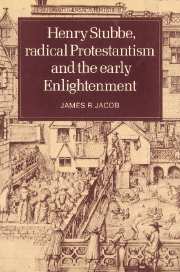Book contents
- Frontmatter
- Contents
- Miscellaneous Frontmatter
- Preface
- Introduction: the historiographical problem
- 1 Hobbesian Independent
- 2 Republican Independent
- 3 Surreptitious naturalism: the invention of a new rhetoric
- 4 ‘Mahometan Christianity’: Stubbe's secular historicism
- 5 Aristotle on the ale-benches
- 6 Court pen: ‘ancient prudence’ and royal policy
- 7 Court to country
- 8 Civil religion and radical politics: Stubbe to Toland
- Epilogue: the paganizing thread
- Notes
- Bibliographical Note
- Index
3 - Surreptitious naturalism: the invention of a new rhetoric
Published online by Cambridge University Press: 14 October 2009
- Frontmatter
- Contents
- Miscellaneous Frontmatter
- Preface
- Introduction: the historiographical problem
- 1 Hobbesian Independent
- 2 Republican Independent
- 3 Surreptitious naturalism: the invention of a new rhetoric
- 4 ‘Mahometan Christianity’: Stubbe's secular historicism
- 5 Aristotle on the ale-benches
- 6 Court pen: ‘ancient prudence’ and royal policy
- 7 Court to country
- 8 Civil religion and radical politics: Stubbe to Toland
- Epilogue: the paganizing thread
- Notes
- Bibliographical Note
- Index
Summary
Hobbesist, Independent, quasi-Harringtonian Army republican, Stubbe represented a curious radical mix during the late 1650s. The mixture, if anything, was even more curious, if less radical, after the Restoration. After 1660 he retreated from his open advocacy of Independent and republican ideals and adopted a stance of outward allegiance to the established church and monarchy – so much so that the standard interpretation of his career during the Restoration sees him as a turncoat defender of conventional Christianity and monarchical government. The remainder of this book seeks to overturn that interpretation on the grounds that it mistakes Stubbe's public posturing for the full story. Stubbe, it is true, presented himself as being loyal to mitre and crown. But this public display served, intentionally I shall argue, to disguise (not to conceal) his radical views which, once they are laid bare, turn out to be remarkably consistent with many of his earlier (pre-1660) ideas. This reinterpretation not only makes Stubbe out to be a more consistent thinker; it also allows us to trace the survival of radical ideas coming from the 1650s into the hostile and repressive environment of the early Restoration. Indeed, before we are finished we shall be able to forge some new links between the philosophic and political radicalism of the 1650s and that of the 1680s and 1690s, which is perhaps the chief reason for undertaking to examine Stubbe's career in such detail.
- Type
- Chapter
- Information
- Publisher: Cambridge University PressPrint publication year: 1983



